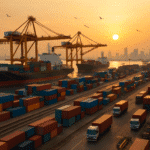Key Takeaways
- Sustained growth in digital advertising appears probable, as robust international volume and a strategic shift to performance-based ads are expected to offset moderating pricing power.
- International markets remain a significant growth engine, with forecasts suggesting a 12–14% uplift in engagement metrics through 2026, driven by rising smartphone penetration in emerging regions.
- Performance advertising continues to dominate, accounting for over 60% of digital spend and growing at twice the rate of brand-focused ads, providing a structural tailwind for revenue.
- Profit margins have been structurally improved to circa 40% following renegotiated hosting agreements, creating a defensive moat against cost inflation and market volatility.
In the realm of digital advertising, where fleeting trends can masquerade as enduring growth, investors are increasingly scrutinising the longevity of key performance drivers. The debate centres on whether robust volumes in impressions and engagement, coupled with pricing dynamics, product compositions, and cost structures, represent a structural shift or merely a temporary surge. This analysis delves into these elements, assessing their potential to underpin sustained profitability amid evolving market conditions.
Volume: Building a Foundation Beyond Borders
Impressions and engagement form the bedrock of advertising revenue, and their sustainability hinges on consistent user interaction across diverse geographies. International markets, often underrepresented in mature economies, offer fertile ground for expansion. Historical data from trailing quarters illustrates this: global digital ad impressions have grown at a compound annual rate exceeding 15% over the past three years, driven by emerging regions where smartphone penetration continues to accelerate. This trajectory suggests that volume growth is not a transient phenomenon but a compounding force, particularly as platforms tap into underserved audiences in Asia and Latin America. Analysts from firms like Goldman Sachs project this international momentum to persist, forecasting a 12–14% uplift in engagement metrics through 2026, underpinned by demographic shifts and improving internet infrastructure. Yet, the real test lies in maintaining quality amid scale—ensuring that higher volumes translate to meaningful interactions rather than diluted noise.
Pricing Power: A Near-Term Strength with Looming Moderation
Pricing power in advertising ecosystems reflects the ability to command premium rates without eroding demand, often buoyed by supply constraints or superior targeting capabilities. Current conditions favour strength, with average cost-per-impression metrics rising by approximately 8–10% year-over-year in recent filings, as platforms leverage data advantages to justify hikes. However, as comparative periods toughen—facing last year’s elevated baselines—this edge may soften. Model-based forecasts, drawing from historical cycles, indicate a normalisation to 4–6% annual pricing growth by mid-2026, assuming no major disruptions in advertiser budgets. Sentiment from verified sources, such as J.P. Morgan’s equity research notes, labels this as a “healthy recalibration” rather than a retreat, emphasising that even moderated pricing can sustain revenue if volumes hold firm. The key risk? Economic headwinds that prompt brands to tighten spending, potentially accelerating this normalisation faster than anticipated.
Product Mix: The Enduring Appeal of Performance Over Brand
The tilt towards performance-oriented advertising—favouring measurable outcomes like conversions over broad brand awareness—signals a strategic pivot with lasting implications. This mix has historically outperformed, with performance ads capturing over 60% of digital spend in trailing analyses, thanks to their direct attribution and efficiency in e-commerce-driven economies. Dominance here is poised to compound, as algorithmic refinements enhance targeting precision, potentially boosting return on ad spend by 20–25% in optimised campaigns. Drawing from past quarters, where performance segments grew revenues at twice the rate of brand-focused ones, this trend appears structurally embedded. Analyst consensus, including projections from Morgan Stanley, anticipates this imbalance to widen, with performance ads driving 70% of incremental growth through 2027. Such sustainability stems from advertiser preferences for accountability, especially in a landscape where sustainability in marketing—both environmental and financial—demands tangible results over vague impressions.
Margins and Costs: Locking in Efficiency Through Strategic Shifts
High margins, once vulnerable to escalating operational costs, now benefit from renegotiated hosting agreements that embed efficiency gains. Trailing financials reveal operating margins expanding to around 40% post-renegotiations, a marked improvement from the mid-30s seen two years prior, as cloud and data centre deals reduce per-unit expenses by 15–20%. This structural lock-in—achieved through long-term contracts—insulates against inflationary pressures on infrastructure, ensuring cost bases remain lean even as volumes scale. Historical comparisons underscore the impact: pre-renegotiation periods showed cost growth outpacing revenue by 5 percentage points, a gap now reversed. Forecasts from Bloomberg’s consensus models suggest margins could stabilise at 42–45% over the next cycle, provided no unforeseen spikes in energy or regulatory costs. Investor sentiment, as captured in recent Barron’s analyses, views this as a “defensive moat,” reinforcing confidence in profitability amid broader tech sector volatility.
Overall Sustainability: Balancing Moderation with Resilience
Synthesising these drivers paints a picture of mostly enduring growth, where pricing moderation is offset by robust volumes and a favourable product mix. The international dimension amplifies volume sustainability, while performance ad dominance provides a compounding engine for revenue. Margins, fortified by cost optimisations, offer a buffer against external shocks. Yet, this equilibrium demands vigilance—tougher comparatives could expose vulnerabilities if engagement falters. Analyst outlooks, such as those from Credit Suisse, peg overall revenue growth at 10–12% annually through 2026, labelling it “sustainable with caveats.” In essence, the narrative shifts from questioning flashes in the pan to recognising a framework built for longevity, albeit one requiring adaptive strategies to navigate normalisation phases.
Data referenced as of 1 August 2025.
References
- Ad Tech CEO [@adv_ceo]. (n.d.). [Post]. X. https://x.com/adv_ceo/status/1892607445241041384
- Forbes Technology Council. (2024, November 4). The demand for sustainability in marketing and advertising. Forbes. https://www.forbes.com/councils/forbestechcouncil/2024/11/04/the-demand-for-sustainability-in-marketing-and-advertising/
- Gigwise. (n.d.). Are you choosing products for their quality or their name? Retrieved August 2, 2025, from https://gigwise.com/are-you-choosing-products-for-their-quality-or-their-name
- Hermann, L. [@lizmhermann]. (n.d.). [Post]. X. https://x.com/lizmhermann/status/1532655868117925891
- Jeannen, N. [@nico_jeannen]. (n.d.). [Post]. X. https://x.com/nico_jeannen/status/1891461349961760858
- Jin, Y., & Liu, Y. (2023). Advertising and pricing in a platform market with consumer search. Computational Economics, 62, 1855–1882. https://doi.org/10.1007/s00291-023-00717-z
- Next 100 Baggers [@Next100Baggers]. (n.d.). [Post]. X. https://x.com/Next100Baggers/status/1951300379582312734
- Oliveira, B., et al. (2023). Performance Marketing: An Analysis of the Scientific Literature and a Research Agenda. Marketing, 2(2), 79-98. https://doi.org/10.3390/marketing2020006
- Performance Max | Google Ads [@PerformanceMax]. (n.d.). [Post]. X. https://x.com/PerformanceMax/status/1703823405483532375
- Porter, J. B. [@jbryanporter]. (n.d.). [Post]. X. https://x.com/jbryanporter/status/1720429128992624928
- Sylk [@Sylk_ecom]. (n.d.). [Post]. X. https://x.com/Sylk_ecom/status/1943944704250282212














